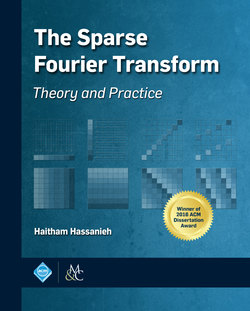Читать книгу The Sparse Fourier Transform - Haitham Hassanieh - Страница 7
ОглавлениеContents
| Preface | |
| Chapter 1 | Introduction |
| 1.1 Sparse Fourier Transform Algorithms | |
| 1.2 Applications of the Sparse Fourier Transform | |
| 1.3 Book Overview | |
| PART I | THEORY OF THE SPARSE FOURIER TRANSFORM |
| Chapter 2 | Preliminaries |
| 2.1 Notation | |
| 2.2 Basics | |
| Chapter 3 | Simple and Practical Algorithm |
| 3.1 Introduction | |
| 3.2 Algorithm | |
| Chapter 4 | Optimizing Runtime Complexity |
| 4.1 Introduction | |
| 4.2 Algorithm for the Exactly Sparse Case | |
| 4.3 Algorithm for the General Case | |
| 4.4 Extension to Two Dimensions | |
| Chapter 5 | Optimizing Sample Complexity |
| 5.1 Introduction | |
| 5.2 Algorithm for the Exactly Sparse Case | |
| 5.3 Algorithm for the General Case | |
| Chapter 6 | Numerical Evaluation |
| 6.1 Implementation | |
| 6.2 Experimental Setup | |
| 6.3 Numerical Results | |
| PART II | APPLICATIONS OF THE SPARSE FOURIER TRANSFORM |
| Chapter 7 | GHz-Wide Spectrum Sensing and Decoding |
| 7.1 Introduction | |
| 7.2 Related Work | |
| 7.3 BigBand | |
| 7.4 Channel Estimation and Calibration | |
| 7.5 Differential Sensing of Non-Sparse Spectrum | |
| 7.6 A USRP-Based Implementation | |
| 7.7 BigBand’s Spectrum Sensing Results | |
| 7.8 BigBand’s Decoding Results | |
| 7.9 D-BigBand’s Sensing Results | |
| 7.10 Conclusion | |
| Chapter 8 | Faster GPS Synchronization |
| 8.1 Introduction | |
| 8.2 GPS Primer | |
| 8.3 QuickSync | |
| 8.4 Theoretical Guarantees | |
| 8.5 Doppler Shift and Frequency Offset | |
| 8.6 Testing Environment | |
| 8.7 Results | |
| 8.8 Related Work | |
| 8.9 Conclusion | |
| Chapter 9 | Light Field Reconstruction Using Continuous Fourier Sparsity |
| 9.1 Introduction | |
| 9.2 Related Work | |
| 9.3 Sparsity in the Discrete vs. Continuous Fourier Domain | |
| 9.4 Light Field Notation | |
| 9.5 Light Field Reconstruction Algorithm | |
| 9.6 Experiments | |
| 9.7 Results | |
| 9.8 Discussion | |
| 9.9 Conclusion | |
| Chapter 10 | Fast In-Vivo MRS Acquisition with Artifact Suppression |
| 10.1 Introduction | |
| 10.2 MRS-SFT | |
| 10.3 Methods | |
| 10.4 MRS Results | |
| 10.5 Conclusion | |
| Chapter 11 | Fast Multi-Dimensional NMR Acquisition and Processing |
| 11.1 Introduction | |
| 11.2 Multi-Dimensional Sparse Fourier Transform | |
| 11.3 Materials and Methods | |
| 11.4 Results | |
| 11.5 Discussion | |
| 11.6 Conclusion | |
| Chapter 12 | Conclusion |
| 12.1 Future Directions | |
| Appendix A | Proofs |
| Appendix B | The Optimality of the Exactly k-Sparse Algorithm 4.1 |
| Appendix C | Lower Bound of the Sparse Fourier Transform in the General Case |
| Appendix D | Efficient Constructions of Window Functions |
| Appendix E | Sample Lower Bound for the Bernoulli Distribution |
| Appendix F | Analysis of the QuickSync System |
| F.1 Analysis of the Baseline Algorithm | |
| F.2 Tightness of the Variance Bound | |
| F.3 Analysis of the QuickSync Algorithm | |
| Appendix G | A 0.75 Million Point Sparse Fourier Transform Chip |
| G.1 The Algorithm | |
| G.2 The Architecture | |
| G.3 The Chip | |
| References | |
| Author Biography |
